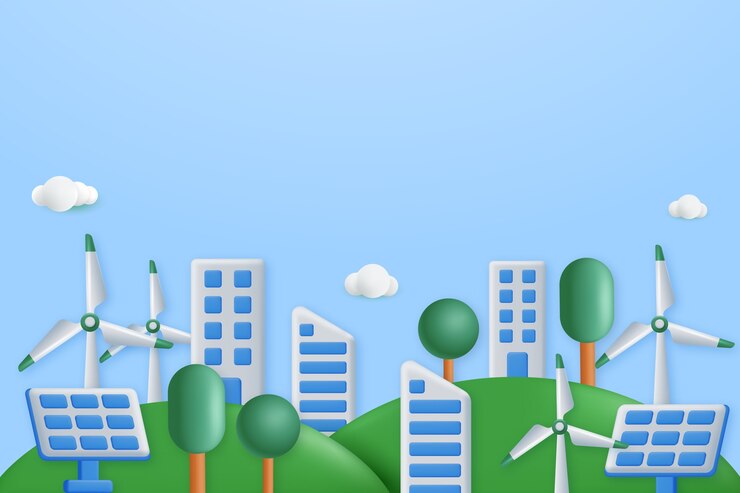As the world grapples with climate change, energy sustainability has become a central focus of global policy and economic discussions. The drive to transition from fossil fuels to renewable energy sources is essential to reducing carbon emissions, mitigating environmental impacts, and ensuring energy security for future generations. While significant strides have been made, achieving energy sustainability presents both challenges and opportunities. Understanding these dynamics is key to accelerating the adoption of sustainable energy practices.
In this article, we will explore the primary challenges and opportunities associated with achieving energy sustainability, and discuss how innovative technologies, policies, and practices can drive the global energy transition forward.
What is Energy Sustainability?
Energy sustainability refers to the ability to meet the energy needs of the present without compromising the ability of future generations to meet their own needs. This concept is not only about reducing reliance on non-renewable energy sources like coal, oil, and natural gas, but also about ensuring that energy systems are socially equitable, economically viable, and environmentally responsible.
Energy sustainability involves:
- Utilizing renewable energy: Solar, wind, geothermal, and hydro power are critical to reducing dependence on fossil fuels.
- Improving energy efficiency: Using energy more efficiently across industries, buildings, and transportation systems.
- Investing in sustainable infrastructure: Creating the physical infrastructure required to support renewable energy sources and smart grids.
- Ensuring social equity: Ensuring all communities have access to affordable, reliable, and clean energy.
Achieving energy sustainability is not just a technical challenge—it requires changes in policy, investment, and behavior across the globe.
The Challenges in Achieving Energy Sustainability
1. Technological Barriers
While renewable energy technologies like solar and wind have made great advances, there are still technological challenges that need to be addressed to make them more efficient and scalable.
- Energy Storage: One of the most significant challenges is improving energy storage technologies. Renewable energy sources like solar and wind are intermittent; they generate electricity only when the sun is shining or the wind is blowing. To make renewable energy reliable, we need advanced storage systems such as batteries that can store surplus energy for later use. Current storage technologies are still costly, with limited capacity, and need to be developed further to support a global energy grid powered by renewables.
- Grid Modernization: The existing electricity grid was designed to accommodate a centralized, fossil-fuel-based power generation system. Transitioning to renewable energy requires modernizing the grid to handle decentralized, fluctuating sources of power. Smart grid technology, which can dynamically manage energy flow and incorporate renewable energy sources, is essential for a sustainable energy future.
- Energy Efficiency Technologies: To reduce energy demand and carbon footprints, industries and homes need to adopt more energy-efficient appliances, machinery, and systems. However, retrofitting old infrastructure and creating affordable energy-efficient technologies for developing economies remain significant hurdles.
2. Economic and Financial Constraints
The transition to renewable energy requires substantial investment in infrastructure, research and development, and energy storage solutions. While the cost of renewable energy technologies has decreased significantly, they still require large upfront capital investments.
- Upfront Costs: Building new energy systems, such as solar power plants, wind farms, and energy storage facilities, demands significant capital. Many governments and corporations are unwilling or unable to make such substantial investments without guaranteed returns. In addition, transitioning to renewable energy requires upgrading existing infrastructure, which can be costly.
- Funding and Subsidies: Fossil fuel industries are still heavily subsidized in many countries, making it difficult for renewable energy to compete on a level playing field. Fossil fuel subsidies drive down the price of non-renewable energy, which makes it harder for renewable energy to gain market share. Phasing out fossil fuel subsidies and directing investments toward clean energy solutions will be crucial in overcoming this financial barrier.
- Market and Policy Uncertainty: The absence of consistent and long-term policies can discourage private investment in renewable energy. Many countries face uncertain regulatory frameworks, making it difficult for investors to predict returns on energy projects. Creating stable policy environments with clear incentives for renewable energy will be crucial for driving investment.
3. Political and Regulatory Challenges
Energy policies and regulations vary widely across countries, making it difficult to establish consistent global standards for energy sustainability. The political will to prioritize energy sustainability over short-term economic growth or national interests is often lacking.
- Lack of Global Coordination: The global nature of climate change requires a coordinated effort to reduce greenhouse gas emissions, but energy sustainability efforts are often hindered by national interests. Some countries may resist moving away from fossil fuels due to economic dependencies or vested political interests in the energy sector.
- Policy Implementation: Even in countries with progressive energy policies, implementation can be slow and inconsistent. The energy transition requires not just ambitious goals but clear regulatory frameworks that promote the development and adoption of renewable energy. Legal and institutional frameworks for energy sustainability need to be strengthened, particularly in developing countries where access to energy is still limited.
- Public Resistance and Misinformation: There can be resistance to energy transitions at the local level due to perceived economic disruptions or misinformation about renewable energy. In some regions, the fossil fuel industry is a significant source of employment, and communities may oppose policy changes that threaten their livelihoods. Ensuring that workers in the fossil fuel industry are retrained for jobs in renewable energy will be key to overcoming this resistance.
4. Environmental and Social Equity Issues
Energy sustainability also involves addressing social and environmental justice issues. While transitioning to clean energy is essential, it is equally important that the benefits of this transition are shared equitably across all communities.
- Access to Clean Energy: While some parts of the world have made significant strides in providing access to clean, affordable energy, many regions—particularly in the Global South—still face energy poverty. The transition to renewable energy must ensure that low-income and remote communities are not left behind in the process.
- Environmental Impacts of Renewable Energy: While renewable energy technologies are much cleaner than fossil fuels, they are not entirely without environmental impacts. For example, large-scale hydroelectric dams can disrupt local ecosystems, and the manufacturing of solar panels and wind turbines can generate waste and emissions. Addressing these environmental challenges and minimizing the negative impacts of renewable technologies is vital for a truly sustainable energy future.
The Opportunities in Achieving Energy Sustainability
Despite the challenges, the transition to a sustainable energy future presents enormous opportunities—both for the economy and the environment.
1. Innovation and Technological Advancements
The push toward energy sustainability is driving a wave of innovation across industries. From advances in solar panel efficiency to the development of next-generation energy storage solutions, the clean energy sector is rapidly evolving.
- Energy Storage Solutions: Companies are investing heavily in improving battery technology to enable efficient storage of renewable energy. Breakthroughs in solid-state batteries, for instance, could significantly reduce storage costs and enhance energy reliability.
- Artificial Intelligence and Smart Grids: AI and machine learning are playing an important role in optimizing energy systems. Smart grids that use AI can efficiently manage the distribution of electricity, balancing supply and demand in real-time, and better integrate renewable energy into the grid.
- Decentralized Energy Systems: Innovations in decentralized energy production, such as rooftop solar panels and small-scale wind turbines, allow communities to generate and manage their own energy. This shift toward localized energy generation reduces transmission losses, increases resilience to power outages, and can lead to significant cost savings.
2. Job Creation and Economic Growth
The transition to renewable energy has the potential to create millions of new jobs globally. The renewable energy sector already employs more people than fossil fuels in many regions, and the continued expansion of this industry will create additional employment opportunities in manufacturing, installation, research, and maintenance.
- Renewable Energy Jobs: According to the International Renewable Energy Agency (IRENA), the renewable energy sector employs more than 11 million people worldwide, with the potential for even greater job creation in the future. This includes roles in solar panel installation, wind turbine manufacturing, battery development, and grid maintenance.
- Clean Tech Startups: The renewable energy revolution is also driving the growth of clean technology startups, which are innovating in areas such as energy efficiency, carbon capture, and sustainable transportation. These startups have the potential to fuel economic growth and create new markets.
3. Environmental Benefits and Climate Change Mitigation
The primary opportunity of achieving energy sustainability lies in mitigating the devastating impacts of climate change. By reducing dependence on fossil fuels and decreasing carbon emissions, the global energy system can help limit global warming and reduce air pollution, which has significant health and environmental benefits.
- Reducing Greenhouse Gas Emissions: Transitioning to renewable energy is a crucial step in achieving the goals of the Paris Agreement and limiting global temperature rise. Renewable energy is virtually carbon-free, and widespread adoption of clean energy technologies will drastically reduce the levels of greenhouse gases in the atmosphere.
- Health Benefits: The shift away from fossil fuels will also result in improved air quality, leading to better health outcomes. Burning coal and oil for energy is a major source of air pollution, which contributes to respiratory diseases, cardiovascular problems, and premature deaths.
4. Sustainable Development Goals (SDGs)
Achieving energy sustainability is aligned with the United Nations Sustainable Development Goals (SDGs), particularly Goal 7: Affordable and Clean Energy. Access to affordable and reliable clean energy is essential for improving living conditions, enhancing education, and promoting economic growth in underserved regions. By investing in renewable energy infrastructure, we can address energy poverty and provide communities with the resources needed to thrive.
Conclusion
Achieving energy sustainability is one of the most critical challenges facing the world today. While there are significant obstacles, such as technological limitations, financial constraints, political barriers, and social equity issues, the opportunities are vast. By investing in innovation, creating supportive policy frameworks, and addressing equity concerns, we can accelerate the transition to a sustainable energy future. The benefits of achieving energy sustainability—reduced environmental impact, improved public health, job creation, and greater economic resilience—make it an endeavor worth pursuing for the betterment of our planet and future generations.

